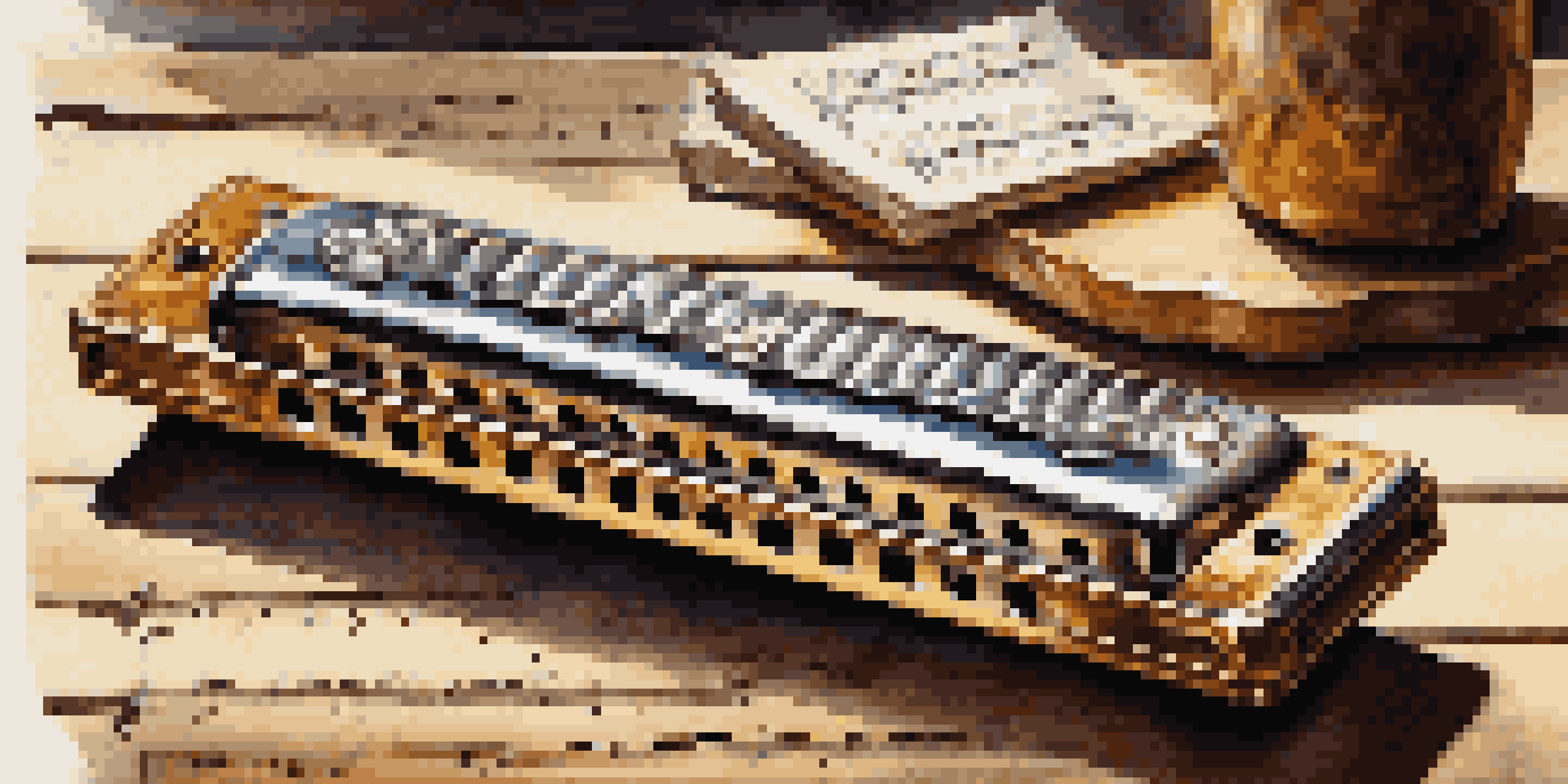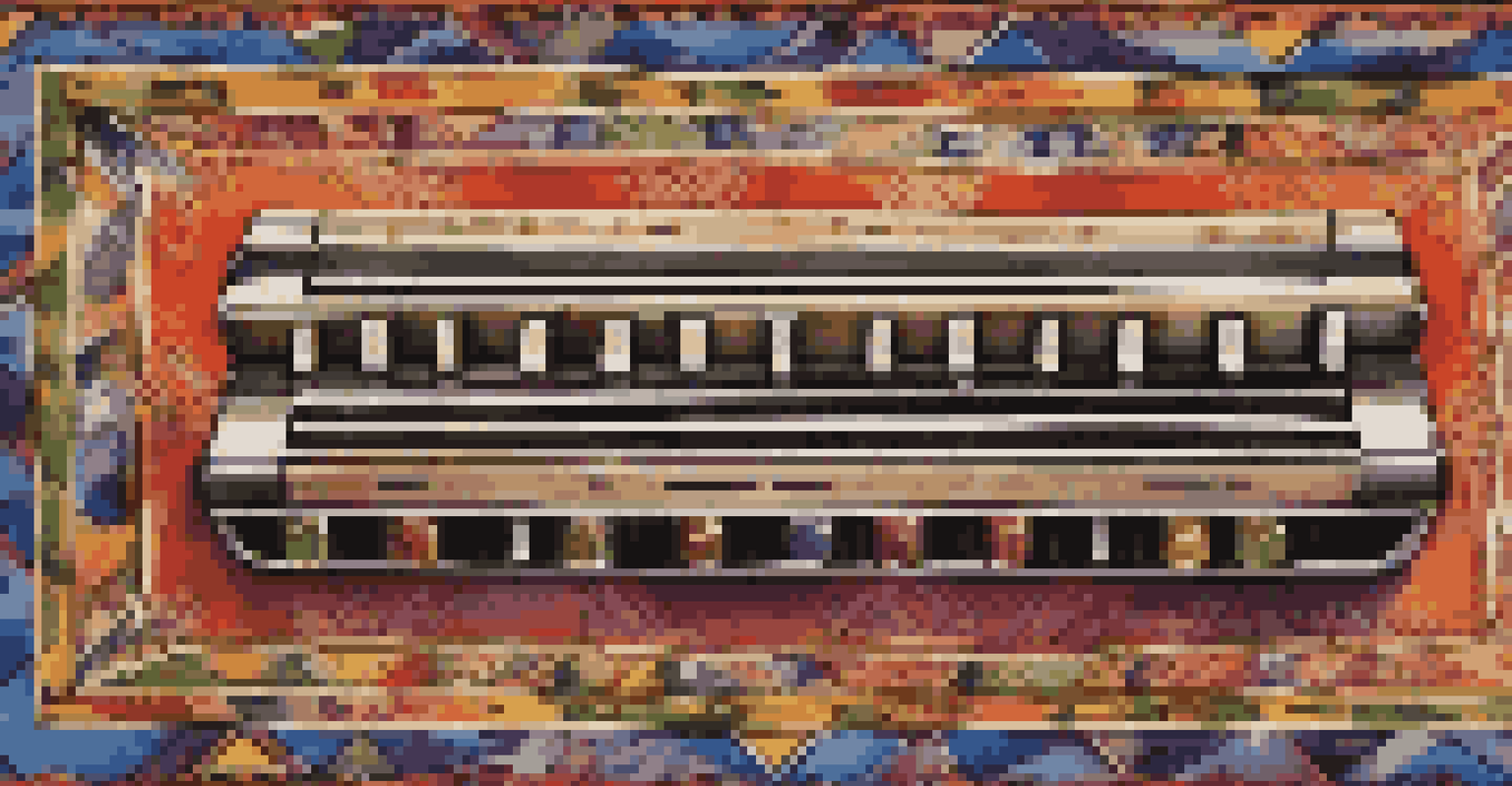The Harmonica: A Portable Instrument with Global Appeal

A Brief History of the Harmonica's Origins
The harmonica, often called the 'mouth organ,' has roots that trace back to ancient China around 3000 BC. It evolved into the free reed instrument we know today in the early 19th century in Europe, specifically Germany. This simple yet captivating instrument quickly found its way to the United States, where it became a staple in folk, blues, and rock music.
The harmonica is the most portable of all instruments, and it can express a wide range of emotions and styles, making it a favorite among musicians.
One of the first commercially successful harmonica manufacturers was Matthias Hohner, who started producing harmonicas in 1857. His instruments gained immense popularity among musicians and enthusiasts alike, giving rise to various playing styles and techniques. The harmonica's portability and affordability made it accessible to people from all walks of life, further enhancing its global appeal.
Over the years, the harmonica has transcended cultural boundaries, adapting to different musical genres while maintaining its signature sound. Today, it’s celebrated not only in American blues but also in classical music, jazz, and even pop. This evolution reflects the harmonica's versatility and its ability to resonate with diverse audiences around the world.
Why the Harmonica is the Perfect Portable Instrument
One of the harmonica's most significant advantages is its portability. Weighing just a few ounces, it can easily fit in your pocket or purse, making it a convenient companion for travel or impromptu jam sessions. Whether you're on a hike, at a picnic, or simply lounging at home, the harmonica is always ready to play.

Unlike larger instruments, the harmonica doesn't require extensive setup or maintenance. It's ready to go straight out of the box, making it an ideal choice for beginners and casual players. Just pick it up, draw a breath, and let your creativity flow – no tuning or complicated assembly required.
Harmonica's Rich Cultural History
The harmonica has ancient roots and evolved into a versatile instrument celebrated across various musical genres worldwide.
This portability fosters a sense of spontaneity in music making. You can share music with friends, entertain family gatherings, or even play solo while contemplating life. The harmonica invites you to express yourself anywhere and anytime, reinforcing its reputation as a truly accessible instrument.
The Harmonica's Global Influence on Music
The harmonica has found its place in various musical traditions around the globe, influencing countless genres. In American blues, it serves as a powerful voice, conveying emotions that words often cannot express. Artists like Little Walter and Muddy Waters helped solidify its status, showcasing its ability to mimic the human voice.
Music brings people together, and the harmonica is a perfect instrument to share that joy, transcending cultural boundaries.
In Europe, the harmonica is commonly featured in folk music, where its bright, expressive tones complement traditional melodies. Many cultures have embraced the harmonica, integrating it into their unique musical styles. For instance, in India, the harmonica is often used in devotional songs, bridging cultural gaps through its universal sound.
As globalization continues to shape the music landscape, the harmonica remains a beloved instrument that transcends borders. Musicians from all backgrounds are inspired to incorporate the harmonica into their works, creating a rich tapestry of sound that highlights its global appeal. This adaptability ensures that the harmonica will continue to resonate with audiences for generations to come.
The Varied Types of Harmonicas Available
Harmonicas come in different types, each designed for specific musical styles and preferences. The most common type is the diatonic harmonica, which is commonly used in blues and folk music. It features a specific set of notes that correspond to a particular key, making it ideal for playing melodies and solos.
Another popular variant is the chromatic harmonica, equipped with a sliding mouthpiece that allows players to access all the notes in the scale. This versatility makes it suitable for jazz and classical music, where complex melodies are often required. Musicians appreciate this type for its ability to navigate different musical intricacies effortlessly.
Portability Enhances Musical Access
Its lightweight design allows the harmonica to be easily carried and played anywhere, making music accessible to everyone.
Additionally, there are tremolo and orchestral harmonicas, each offering unique sounds and applications. Tremolo harmonicas have two reeds per note, creating a vibrating effect, while orchestral harmonicas come with multiple rows of reeds, allowing for rich harmonies and chords. This diversity ensures that there's a harmonica for every type of player and musical preference.
Learning to Play the Harmonica Made Easy
One of the best aspects of the harmonica is that it's beginner-friendly. Many resources are available, from online tutorials to instructional books, making it easy for aspiring musicians to get started. Even if you've never played an instrument before, the harmonica's straightforward design allows you to produce music quickly.
Practicing simple techniques, such as single note playing and bending, can lead to a rewarding learning experience. You can start with basic songs and gradually progress to more complex pieces as you build your skills. The sense of accomplishment that comes with mastering a song is incredibly motivating, especially for beginners.
Joining harmonica clubs or online communities can also enhance your learning journey. Connecting with fellow enthusiasts provides opportunities to share tips, exchange ideas, and even collaborate on music. This sense of community makes learning the harmonica not just an individual pursuit, but a shared passion that fosters friendships.
The Harmonica in Popular Culture
The harmonica has made its mark in popular culture through countless songs and performances. Iconic tracks like Bob Dylan's 'Mr. Tambourine Man' and Neil Young's 'Heart of Gold' feature the harmonica prominently, showcasing its emotive qualities. These songs have introduced the instrument to new generations, solidifying its place in modern music.
Beyond music, the harmonica has appeared in films and television shows, often symbolizing a sense of nostalgia or adventure. Think of classic Westerns, where the harmonica evokes the spirit of the open frontier, or scenes highlighting characters reminiscing about the past. This cultural representation reinforces the harmonica's universal appeal and emotional depth.
Harmonica's Enduring Popularity
With its presence in popular culture and contemporary music, the harmonica remains a relevant and beloved instrument for new generations.
As musicians continue to experiment with different sounds, the harmonica remains a relevant and versatile instrument. Contemporary artists across genres incorporate the harmonica into their music, ensuring its continued presence in popular culture. This enduring legacy highlights the harmonica's adaptability and timeless charm.
The Future of the Harmonica in Music
As we move forward in the music landscape, the harmonica continues to evolve and inspire new generations of musicians. With the rise of technology, innovative approaches to music-making are emerging, allowing for fresh sounds and styles to be explored. Electronic harmonicas and effects pedals are becoming more common, pushing the boundaries of traditional playing.
Moreover, the harmonica's accessibility means that it will likely remain a popular choice for budding musicians. As schools and community programs incorporate music education, the harmonica's simplicity makes it an ideal instrument for introducing kids to the world of music. This foundation fosters creativity and encourages lifelong musical exploration.

Ultimately, the harmonica's rich history and global appeal ensure that it will continue to resonate with audiences for years to come. Whether as a solo instrument or part of a larger ensemble, the harmonica's unique voice will keep captivating hearts and minds, celebrating its place in the tapestry of music.